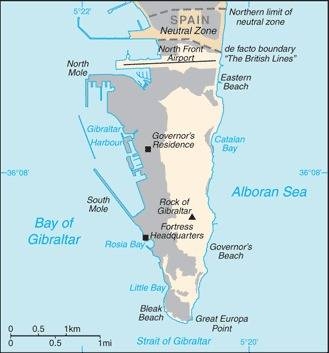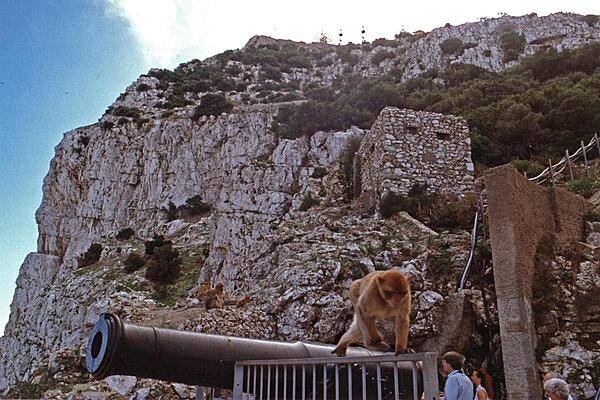121 Gibraltar (UK)

Two horizontal bands of white (top, double width) and red with a three-towered red castle in the center of the white band. Hanging from the castle gate is a gold key centered in the red band. The design is that of Gibraltar’s coat of arms granted on 10 July 1502 by King Ferdinand and Queen Isabella of Spain. The castle symbolizes Gibraltar as a fortress, while the key represents Gibraltar’s strategic importance – the key to the Mediterranean.
Flag courtesy of the CIA World Factbook

Map courtesy of the CIA World Factbook

Some of the old defenses on The Rock of Gibraltar.
Photo courtesy of the CIA World Factbook
Last updated on October 24, 2025
Government
According to Britannica, Gibraltar is an overseas territory of the United Kingdom and is self-governing in all matters but defense. Its constitution was established by the Gibraltar Constitution Order in 1969, which provided for a House of Assembly consisting of the speaker (appointed by the governor), 15 members elected to four-year terms, and 2 ex-officio members. (A new Constitution Order was approved by referendum in November 2006 and was implemented in January 2007; it renamed the House of Assembly as the Gibraltar Parliament and increased its number of members to 17.) In 1981 Gibraltarians were granted full British citizenship. Gibraltarians age 18 or older and British civilians resident for more than six months are entitled to vote. The governor, appointed by the British sovereign, is the head of the executive Gibraltar Council and appoints the Council of Ministers, composed of the chief minister and other ministers, from the party or coalition of parties that gains a majority of seats in the Gibraltar Parliament. Instead of a city council, one minister is responsible for municipal affairs.
Office of the Director of Civil Aviation
The Office of the Director of Civil Aviation was established by the Civil Aviation Act 2009 on 29th January 2009. The purpose of this act is identified as An act to make provision generally for the regulation of civil aviation (save for aviation security) in Gibraltar; to provide for the management and control of the commercial and civil use of the airport and of the air terminal and aircraft using its facilities; and for connected purposes. The Director of Civil Aviation reports to the Minister for Aviation for the discharge of his duties and functions under the act.
Airspace
SkyVector – Google Maps – ADS-B Exchange
ICAO countries publish an Aeronautical Information Publication (AIP). This document is divided into three parts: General (GEN), En Route (ENR) and Aerodromes (AD). ENR 1.4 details the types of airspace classes they chose to adopt from classes A through G.
Drone Regulations
Advanced Air Mobility (AAM) Regulations & Policies
None found by the author.
However, should you, the reader, happen to stumble across something to the contrary, please email the author at FISHE5CA@erau.edu and you may be mentioned in the ACKNOWLEDGEMENTS section of this book by way of thanks for contributing to this free eBook!
Advanced Air Mobility (AAM) News
None found by the author.
However, should you, the reader, happen to stumble across something to the contrary, please email the author at FISHE5CA@erau.edu and you may be mentioned in the ACKNOWLEDGEMENTS section of this book by way of thanks for contributing to this free eBook!
Short Essay Questions
Scenario-Based Question
You have been hired by a Drone Startup Company. Your boss has immediately assigned this job to you.
They need you to prepare a one-page memo detailing the legalities of using a drone to film the Rock of Gibraltar, pictured above.
They need you to mention any national laws and local ordinances.
They specifically want to know what airspace (insert pictures) you will be operating in and whether or not you need an airspace authorization.
Does it matter whether or not you are a citizen of the country?
Lastly, there is a bonus for you if, as you scroll through this chapter, you find any typos or broken links!
Short Essay Questions
- What are the drone categories?
- How is registration addressed?
- How is remote ID addressed?
- What are the model aircraft rules?
- What are the commercial drone rules?
- Are there waivers or exemptions to the rules? If so, for what?
- Would you share a link to an interactive airspace map?
- How is BVLOS addressed?
- How can you fly drones at night?
- How can you fly drones over people?
- Where do you find drone NOTAMs?
- What are the rules for drone maintenance?
- What are the rules for an SMS program?
- What are some unique rules not mentioned above?
- What are the C-UAS rules?
- What are the AAM rules?

